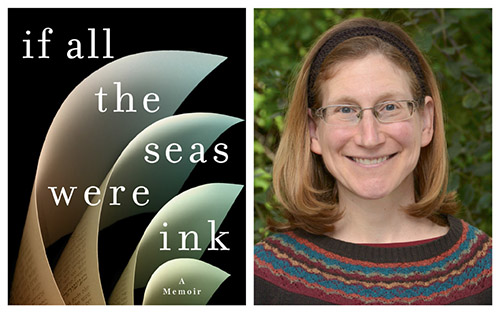
Reviewing: “If All the Seas Were Ink: A Memoir,” by Ilana Kurshan. St. Martin’s Press, hardcover, 320 pages; 2017. ISBN-10: 1250121264
Ilana Kurshan has written an important, interesting and often light-hearted book chronicling her decade-plus of daily study of the Talmud, known as the Daf Yomi, an idea first proposed by Rabbi Meir Shapiro in Lublin in 1930. She will speak about her book in Teaneck on November 9, at Congregation Rinat Yisrael (389 West Englewood Ave., Teaneck), at 8 p.m. Her book can be appreciated at multiple levels, and certainly is of interest to those who study the daf as well as those who do not.
For those who enjoy personal stories, it is, at its essence, a personal memoir chronicling the author’s growth and personal development and her klita (assimilation) into Israeli society, interwoven with some of her sartorial choices and even interactions with friends and boyfriends. It is also a fine introduction to the Talmud. Finally, her frequent quotations, all fully sourced, will interest even life-long students of the Talmud. Ms. Kirshon was well-trained at Harvard and Cambridge, so she applies a scholar’s critical eye along with her obvious love of her subject.
The book’s unusual title, “If All the Seas Were Ink,” is an allusion to the “sea” of the Talmud and also to the much-beloved liturgical Shavuot piyyut, Akdamut, composed in Aramaic around 1050 by Rabbi Meir bar Yitzhak of Orleans, which encodes the message that a Jew never stops learning Torah.
The book opens in a rather melancholy way; we meet the author as she recovers from a short, failed first marriage; she has few friends in Jerusalem, and describes beginning her daily Talmud studies practically on a whim, when it was suggested by a running buddy. Taking us along on her journey, she comes a long way in a decade. Much to her own surprise, she finds her bashert—her predestined beloved—but she is rather coy on the details. As she builds a family, her mood lifts and the book becomes more upbeat.
Ms. Kurshan’s day job is as an editor and a translator of quality Jewish literature, including “A Bride for One Night” by Dr. Ruth Calderon, an avowedly secular Talmudist who famously taught a Talmudic passage at her inaugural speech at the Knesset in 2013. She has also translated books by Benjamin Lau and Micah Goodman, as well as novels, short story collections and children’s picture books. She is a regular contributor to Lilith Magazine, where she serves as the book reviews editor, and her writing has appeared in The Forward, The World Jewish Digest, Hadassah, Nashim, Zeek, Kveller and Tablet. She is also the author of a previous book, “Why Is This Night Different From all Other Nights: The Four Questions Around the World.”
I have previously written extolling the virtues of studying Talmud b’chavruta (with a study buddy). A married mother of four with a busy career, Ms. Kurshan told me she studies the daf these days mostly on her own, stealing time early in the day, late at night, on buses and so on. Many others squeeze Daf Yomi into their schedules the same way. She also referred to a number of different online recordings she has used, in addition to joining Daf Yomi groups at a local shul.
Having done it both ways, I continue to feel a study buddy works best—if for no other reason than the mutual dependence it creates ensures actually doing it every day. I admit, though, that more than a few health challenges have resulted in my studying without a chavruta in recent years, but assisted by the many online aids and especially Sefaria.org. The Talmud itself mentions the importance of a study buddy (“O chavruta, o mituta”—Taanit 23a), which Jacob Neusner provocatively translated as “Give me havruta or give me death.”
Ms. Kurshan organized her book around the order of the tractates of the Talmud as she learned it, and willy-nilly you are getting a Reader’s Digest condensed version of the Talmud’s 5,894 folio pages, often interweaved with the author’s intimate thoughts. For example, “Since I usually ate my Shabbat meals alone, I rarely bothered to prepare something elaborate…one week I was preparing a salmon.” Other details Kurshan shares seem less relevant to the Talmud and more like fleeting diary-style thoughts, such as a short treatise on the differences between people who carry umbrellas and those who wear raincoats.
To her credit as a writer, Ms. Kurshan delves into source material even while making these kinds of oblique statements, so she holds the reader’s interest regardless of her subject matter. Other thoughts she shares, though, on the concept of beauty, for example, provide intimate glances into the life of a woman who gives the impression that she cares little about her own external beauty. Through the lens of the daf, however, she envisions the different commentators as characters speaking with each other about women’s beauty generally, while she observes them as a bystander.
By David E. Y. Sarna
David E. Y. Sarna is an author, frequent Jewish Link contributor and a Daf Yomi fan. He and his wife are long-time residents of Bergen County where they are members of Cong. Bnai Yeshurun. He wishes to extend his thanks and a hakarat hatov to all who have been helping him as he recovers from a serious stroke.











